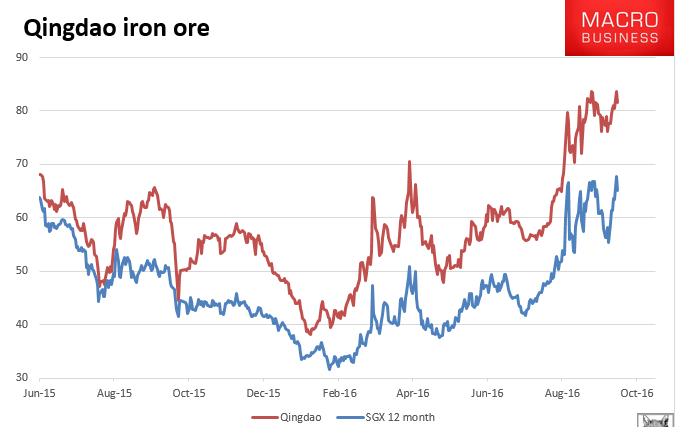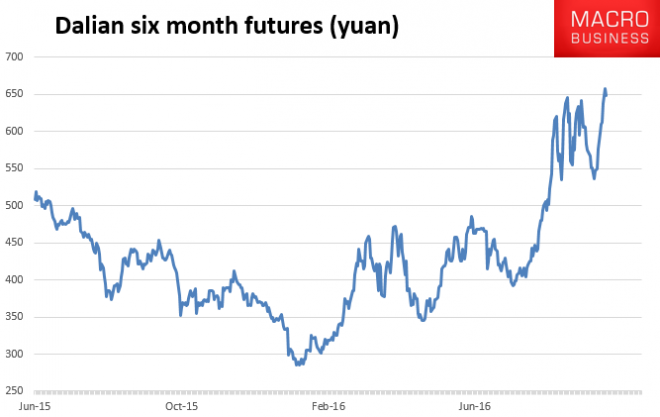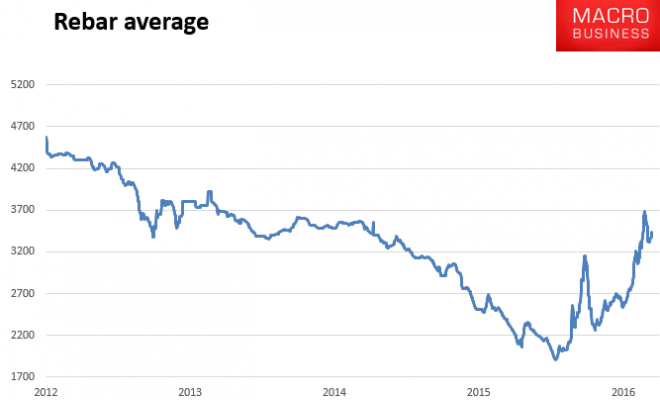The brokers are rubbing their hands with anticipation that Rio Tinto is going to do some serious capital management. Read: lift dividends and do share buybacks to lift share prices and create more bonuses for executives instead of squirreling away funds for when iron ore prices go back to $40USD or less a ton.
Spot iron ore prices have come back sharply, with futures off nearly 4% while rebar prices stabilise:




From AFR:
After a slow start to 2016, Rio exported iron ore from Western Australia at an annualised rate of 350 million tonnes in the December quarter, and the annualised rate was 370 million tonnes if the company’s Canadian iron ore assets were included.
The strong prices have come despite an apparent oversupply of the steel-making ingredient, and have fuelled speculation that Rio will launch a round of share buybacks next month.
Shaw and Partners analyst Peter O’Connor said capital management would be back on Rio’s agenda in 2017, and he was increasingly confident it could come as early as the full year financial results on February 8.
Mr O’Connor said the combination of high iron ore prices, the weak British currency and Rio’s debt being near the bottom of the company’s target range suggested buybacks were now possible, with the company’s London listed shares a likely target of any buyback program.
Rising expectations for shareholder returns come less than a year after Rio was forced to axe its generous progressive dividend policy because of the gloomy outlook for the mining sector.
Rio has guaranteed its shareholders will receive at least $US1.10 per share for 2016, but Macquarie has forecast $US1.31.
“Should prices remain buoyant, the likelihood of increased cash returns to shareholders this year is rising,” said Macquarie analyst Hayden Bairstow in a note published on Tuesday.
Morgan analyst Adrian Prendergast added that low capital spending plans was another reason why Rio may be able to boost shareholder returns and conduct buybacks.
“Among its Australian peers we view Rio as being the strongest candidate for a potential dividend increase or share buyback surprise when it releases its full year result,” he said in a note.
Mr Prendergast upgraded his forecast for Rio’s underlying net profit after tax by 42 per cent to $US4.47 billion. Analyst consensus measured by Bloomberg suggests Rio’s full year profit will be about $US4.52 billion.
But the iron ore price rally may have peaked; Rio’s strong finish to 2016 and first exports from Vale’s giant S11D iron ore project in Brazil spooked Dalian iron ore futures, which dipped on Tuesday afternoon on expectation that supply of iron ore will increase.
Meanwhile, analysts are “bamboozled” why iron ore prices are so much higher:
The recent strength in iron ore prices has come despite stockpiles of the commodity in China being close to record highs, prompting J-Capital partner Tim Murray to dub the recent price strength as “bamboozling”.
“When you can’t find a reasonable explanation for why prices are staying so high I would have to say that is a strong indicator they are about to go down,” he told The Australian Financial Review.
Macquarie analysts said a Chinese Government push to shut down low quality steel producers in the middle kingdom could be reducing demand for scrap steel and increasing the amount of iron ore used in steel production, but the analysts said the dynamic was not enough to justify the recent price strength.
“Everything tells you it should be closer to $US50 per tonne by the end of the year, it doesn’t feel right at $US80 per tonne,” said Mr O’Connor.
“The current positive industry sentiments can be linked to the fact that iron ore is heavily leveraged off the infrastructure investment cycle in China, which continues to perform stronger than what doomsayers have predicted for the last two years,” he told The Australian Financial Review.
“As long as there is an annual China GDP increase of around 7 per cent, steel demand growth will also remain relatively stable.”
“As long” – those two words are fraught with fragility.